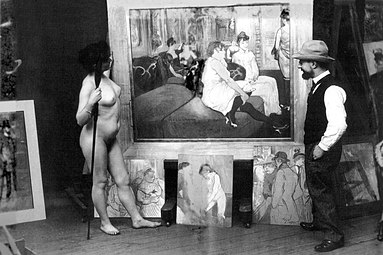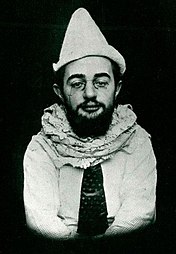Henri de Toulouse-Lautrec
Henri Marie Raymond de Toulouse-Lautrec-Montfa (Albi, November 24, 1864-Saint-André-du-Bois, September 9, 1901), known simply as Toulouse -Lautrec, was a French painter and poster artist, who stood out for the representation of Parisian nightlife at the end of the XIXth century. He is part of the post-impressionist movement.
Childhood
He was born in the castle of Albi into a noble family. In his family, as was customary in many dynasties of the old aristocracy, many marriages were arranged between relatives to avoid territorial divisions and the dispersal of fortune. This was the case of Henri's parents, Count Alphonse de Toulouse-Lautrec-Montfa (1838-1913) and Adèle Tapié de Celeyran (1841-1930), who were first cousins. Inbreeding had to condition the artist's health. Henri was the firstborn and when he was four years old his brother Richard-Constantine was born, who died a year later. His parents separated in 1868 and he was left in the care of his mother.
His childhood was happy despite the fact that he suffered from a disease that affected bone development and that began to manifest in him in 1874. His bone constitution was weak and between May 1878 and August 1879 he suffered two fractures in the femurs of both legs, which prevented him from growing further, reaching a height of 1.52 m, despite the fact that his mother, concerned about his health and growth, consulted numerous doctors and took him to take thermal baths.
Since he was a child he liked drawing, drawing sketches of horses in his school notebooks; His father was a great fan of hunting and horse riding, the landscapes around the castle and his family. Realizing his talent, a friend of his father, the painter René Princeteau, gave him some private lessons.
Career in Paris
Toulouse-Lautrec decided to be a painter, and with the encouragement of his uncle Charles and various painters friends of the family, such as Princeteau, John Lewis Brown, and Jean-Louis Forain, he went to live in Paris in 1881. There, he was a student by Léon Bonnat, who was a fashionable portrait painter, and, when Bonnat's studio closed in September 1882, he had to find a new teacher, who was Fernand Cormon. In Cormon's studio he became friends with Vincent van Gogh.
In 1884 Toulouse-Lautrec went to live in the Montmartre neighborhood, where he had neighbors like Edgar Degas. The fascination he felt for nightlife venues led him to frequent them regularly and become a regular customer of some of them, such as the Salon de la Rue des Moulins, the Moulin de la Galette, the Moulin Rouge, Le Chat Noir or the Folies Bergère. Everything related to this world, including prostitution, was one of the main themes in her work. In his works of the underworld of Paris he painted actors, dancers, bourgeois and prostitutes. He painted these in his daily life: while they were changing, when they finished each service or when they were waiting for a medical inspection.
Unlike the Impressionist artists, he was hardly interested in the landscape genre, preferring closed environments, illuminated with artificial light, which allowed him to play with colors and framings in a subjective way. Very observant, he was attracted to the gestures of singers and comedians, and he liked to ridicule the hypocrisy of the powerful, who loudly rejected the same vices and atmospheres that they tasted in private.
The owners of the cabarets asked him to draw posters to promote their shows, something that Lautrec was very excited about, since during his long nights in these places he drew everything he saw and left it for the tables. Unlike the misunderstood Vincent van Gogh, Toulouse-Lautrec went on to sell and gain recognition, though his popularity rested on his magazine illustrations and billboards rather than oil painting.
She had great friends like the dancer Jane Avril, to whom she dedicated several paintings and posters. She met renowned dancers such as Valentín el Descoyuntado, clowns and other characters from parties and shows in the suburbs. This world of vice and extravagance was a refuge for Lautrec, who felt rejected by the nobility to which he belonged by origin. His disability caused rejection in chic salons, and in Montmartre he was able to go unnoticed and give free rein to his bohemia. He criticized all those who reflected landscapes in his paintings, since he believed that what was truly worthwhile were the people, the town. He considered himself a social chronicler and mixed, painted and was like the people. He painted great works like The Medical Inspection.
In 1886 he left Cormon's studio and leased his own. In the 1890s he traveled to London, where he met and photographed Oscar Wilde; He also designed the handout (pamphlet or booklet) handed out at the Parisian premiere of his drama Salomé.
He had problems with alcohol and also contracted syphilis, which often led to fits of madness. Alcoholism deteriorated her health, and from 1897 she suffered from mania, depression and neurosis, as well as attacks of paralysis in her legs and on one side. In 1897 he had to be picked up from the streets due to drunkenness, and soon after in a delirium tremens he went so far as to shoot the walls of his house, believing them to be crawling with spiders. However, he continued to paint steadily and quickly; but they picked him up again drunk in 1899 and admitted him to a mental hospital, where he made a collection of paintings about the circus. They let him go to his mother's house on the estate near Bordeaux, and on September 9, 1901, he died bedridden in his Château Malromé.
In 1922 his mother and his dealer opened the Toulouse-Lautrec Museum in the Palais de la Berbie in Albi, much visited and renowned for its extensive collection.
Work
Toulouse-Lautrec's work is characterized by his photographic style, which corresponds to spontaneity and the ability to capture movement in his scenes and characters, his being a very characteristic style. To this we must add the originality of his framing, influenced by Japanese art, which is manifested in the diagonal compositional lines and the sudden cutting of the figures at the edges. He had a photographic memory and painted very quickly. However, his first influence was impressionist painting and, above all, the figure of Edgar Degas, whose urban theme he followed, moving away from the landscapes interpreted by Monet or Renoir. He was at the forefront of modernism and Art Nouveau.
Lautrec was fundamentally a draftsman and illustrator, tasks that allowed him to survive. His oil paintings are comparatively rare and he hardly exhibited them in his lifetime. Unlike van Gogh, his fame as an outsider did not imply that he was a failed artist; and in fact he was very popular because of his illustrations and publicity posters. He contributed fifteen designs to the weekly Le Rire and also illustrated the program for the theatrical release of Salomé , by Oscar Wilde.
His works include the following:
- Self-portrait in front of the mirror (on cardboard oil, 1880).
- Cavalry lackey with two horses (on cardboard oil, 1880).
- Count Alphonse of Toulouse-Lautrec drives his four-horse car (on canvas, 1881).
- The mother of the artist, Countess Adèle de Toulouse-Lautrec, having breakfast at the Castle Malromé (on canvas, 1881-1883).
- Young Routy at Céleyran (on canvas, 1882).
- The fat Marie Martin (on canvas, 1884).
- The lavender (on canvas, 1884).
- Portrait of Vincent van Gogh (Patel on cardboard, 1887).
- Amazon in the circus Fernando (on canvas, 1888).
- Mademoiselle Marie Dihau piano (on cardboard oil, 1890).
- In the Moulin de la Galette (on canvas, 1889).
- Dance at the Moulin Rouge (on canvas, 1890).
- Moulin Rouge: the Goulue (colorlitography, 1891).
- Reine de joie (colored lithography, 1892).
- Ambassadeurs: Aristide Bruant (colored lithography, 1892).
- English at the Moulin Rouge (oleo and gouache on cardboard, 1892).
- In bed: the kiss (on canvas, 1892)
- In the Moulin Rouge: two women dancing (on cardboard, 1892), National Gallery, Prague
- Divan de Carmenchu (colorlitography, 1892-1893).
- Yvette Guilbert (gouache on cardboard, 1894), Museo Thyssen-Bornemisza, Madrid.
- Paris Garden: Jane Avril (colored lithography, 1893).
- Medical inspection (only on cardboard, 1894).
- Confetti (colored lithography, 1894).
- Rue des Moulins Hall (on canvas, h. 1894), Toulouse-Lautrec Museum, Albi
- The payasa Cha-U-Kao (on cardboard, 1895), Orsay Museum, Paris
- The cabin passenger (colored lithography, 1896).
- The bathtub (colored lithography, 1896).
- The toilette (on cardboard, 1896), Orsay Museum, Paris
- Walk through the countryside (colored lithography, 1897).
- The redhead with white blouse (on canvas), Thyssen-Bornemisza Museum, Madrid.
Gallery
Paintings
Posters
Photography
Portrait in the cinema
- Moulin Rouge (1952), led by John Huston. With seven Oscar nominations, he won the awards for best artistic direction and best costumes. The film narrates in the key of musical drama the life of Henri de Toulouse-Lautrec (José Ferrer in the main role), the French painter and posterist of the end of the centuryXIX, and the first artist who in life could exhibit his work at the Louvre. This film highlights its main theme "Song of the Moulin Rouge", by Georges Auric.
- Lautrec (1998), led by Roger Planchon and interpreted by Regis Roger. Call in Spain Toulouse-Lautrec, this French film is considered as biopic of the artist.
- Moulin Rouge! (2001), led by Baz Luhrmann. Musical film with great doses of fantasy and anachronisms, presents to a Toulouse something different, being in the background in the film. The actor who played it was the Colombian John Leguizamo.
- Midnight in Paris (2011), directed by Woody Allen. In this ribbon Toulouse-Lautrec was played by Vincent Menjou Cortés.
Contenido relacionado
Gardening
Dry point engraving
Art in spain















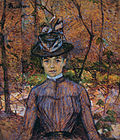








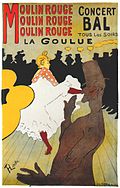




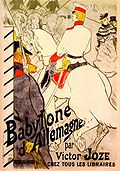





![El museo Toulouse-Lautrec,[4] fundado por su madre después de su muerte](https://upload.wikimedia.org/wikipedia/commons/thumb/5/5c/%28Albi%29_Entr%C3%A9e_du_Mus%C3%A9e_Toulouse-Lautrec_sur_la_place_sainte_C%C3%A9cile.jpg/383px-%28Albi%29_Entr%C3%A9e_du_Mus%C3%A9e_Toulouse-Lautrec_sur_la_place_sainte_C%C3%A9cile.jpg)
!["La fealdad, donde quiera que esté, siempre tiene un lado bello; es fascinante lograr la belleza donde nadie más la puede ver" - Toulouse-Lautrec[5]](https://upload.wikimedia.org/wikipedia/commons/thumb/4/40/Lautrec_maluici.jpg/373px-Lautrec_maluici.jpg)

